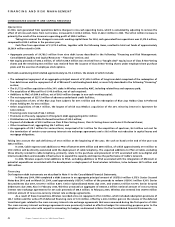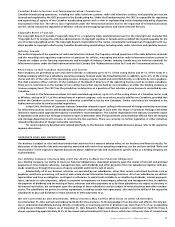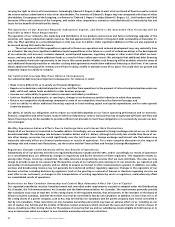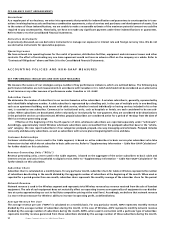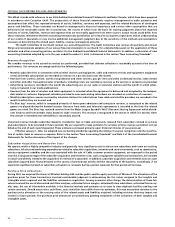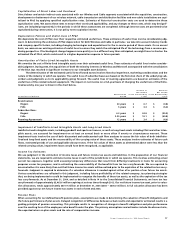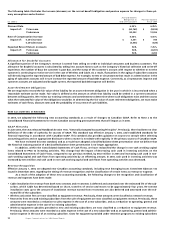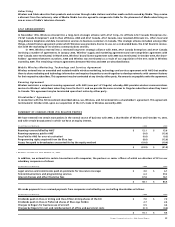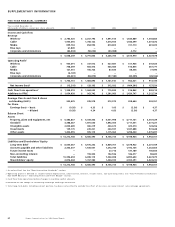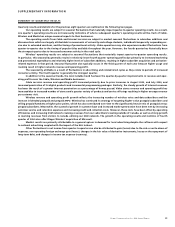Rogers 2004 Annual Report Download - page 58
Download and view the complete annual report
Please find page 58 of the 2004 Rogers annual report below. You can navigate through the pages in the report by either clicking on the pages listed below, or by using the keyword search tool below to find specific information within the annual report.
56 Rogers Communications Inc. 2004 Annual Report
CRITICAL ACCOUNTING POLICIES AND ESTIMATES
This MD&A is made with reference to our 2004 Audited Consolidated Financial Statements and Notes thereto, which have been prepared
in accordance with Canadian GAAP. The preparation of these financial statements requires management to make estimates and
assumptions that affect the reported amounts of assets, liabilities, revenues and expenses, and the related disclosure of contingent
assets and liabilities. These estimates are based on management’s historical experience and various other assumptions that are
believed to be reasonable under the circumstances, the results of which form the basis for making judgments about the reported
amounts of assets, liabilities, revenue and expenses that are not readily apparent from other sources. Actual results could differ from
those estimates. We believe that the accounting estimates discussed below are critical to our business operations and an understanding
of our results of operations or may involve additional management judgment due to the sensitivity of the methods and assumptions
necessary in determining the related asset, liability, revenue and expense amounts.
The Audit Committee of our Board reviews our accounting policies. The Audit Committee also reviews all quarterly and annual
filings and recommends adoption of our annual financial statements to our Board. For a detailed discussion on the application of these
estimates and other accounting policies, see Note 2 to the Audited Consolidated Financial Statements. In addition, a discussion of new
accounting standards adopted by us in the year ended December 31, 2004, is discussed in the section “New Accounting Standards”.
Revenue Recognition
We consider revenues to be earned as services are performed, provided that ultimate collection is reasonably assured at the time of
performance. Our revenues are categorized into the following types:
• Monthly subscriber fees in connection with wireless services and equipment, cable and Internet services and equipment, equipment
rental and media subscriptions are recorded as revenue on a pro rata basis over the month;
• Revenue from wireless airtime, wireless long-distance and other services, pay-per-view and video on demand movies, video rentals
and other and other transactional sales of products, including retail, are recorded as revenue as the services or products are provided;
• Advertising revenue is recorded in the month the advertising airs on our radio or television stations and the month in which adver-
tising is featured in our media publications;
• Revenue from the sale of wireless and cable equipment is recorded when the equipment is delivered and accepted by the indepen-
dent dealer or customer. Equipment subsidies provided to new and existing subscribers are recorded as a reduction of revenues;
• Monthly subscription revenue received by television stations for subscriptions from cable and satellite providers are recorded in the
month in which they are earned; and
• The Blue Jays’ revenue, which is composed primarily of home game admission and concession revenue, is recognized as the related
games are played during the baseball season. Revenue from radio and television agreements is recorded at the time the related
games are aired. The Blue Jays received revenue from the Major League Baseball (“MLB”) Revenue Sharing Agreement which distrib-
utes funds to and from member clubs, based on clubs’ revenues. This revenue is recognized in the season in which it is earned, when
the amount is estimable and collectibility is reasonably assured.
Unearned revenue includes subscriber deposits, installation fees at Cable and amounts received from subscribers related to services
and subscriptions to be provided in future periods. We are required to make estimates for wireless airtime revenue earned but not yet
billed as the end of each reporting period. These estimates are based primarily upon historical minutes of use processed.
Effective January 1, 2004, we adopted new accounting standards regarding the timing of revenue recognition and the classifica-
tion of certain items as revenue or expense. Refer to the section “New Accounting Standards” and Note 2 of the Consolidated Financial
Statements for further discussion of the impact of the changes.
Subscriber Acquisition and Retention Costs
We operate within a highly-competitive industry and generally incur significant costs to attract new subscribers and retain our existing
subscribers. All sales and marketing expenditures related to subscriber acquisitions, retention and contract renewals, such as commissions,
wireless equipment subsidies and the cost associated with the sale of Cable customer premise equipment, are expensed in the period
incurred. A large percentage of the subscriber acquisition and retention costs, such as equipment subsidies and commissions, are variable
in nature and directly related to the acquisition or renewal of a subscriber. In addition, subscriber acquisition and retention costs on a per
subscriber acquired basis fluctuate based on the success of promotional activity and the seasonality of the business. Accordingly, if we
experience significant growth in subscriber activations or renewals during a period, expenses for that period will increase.
Purchase Price Allocations
During 2004, we acquired the shares of Wireless held by AWE and the public and the equity securities of Microcell. The allocations of the
purchase prices for these transactions involved considerable judgment in determining the fair values assigned to the tangible and
intangible assets acquired and the liabilities assumed on acquisition. Among numerous other things, the determination of these fair
values involved the use of discounted cash flow analyses, estimated future margins, estimated future subscribers, estimated future roy-
alty rates, the use of information available in the financial markets and estimates as to costs to close duplicate facilities and buy out
certain contracts. Should actual rates, cash flows, costs and other items differ from our estimates, this may necessitate revisions to the
purchase price allocation or the carrying value of the related assets and liabilities acquired, including revisions that may impact net
income in future periods. The purchase price allocations are preliminary pending completion of the valuations of both tangible and
intangible assets.


